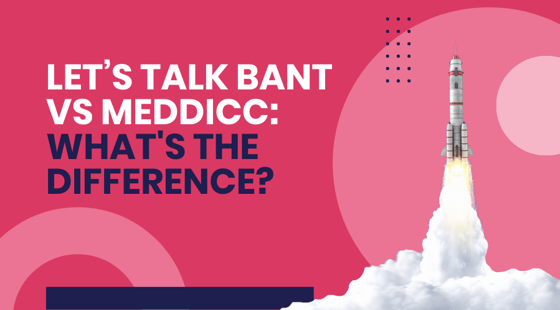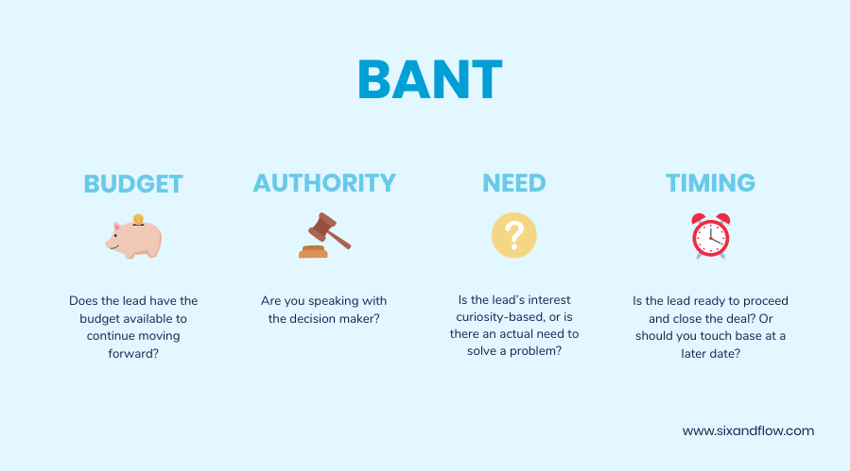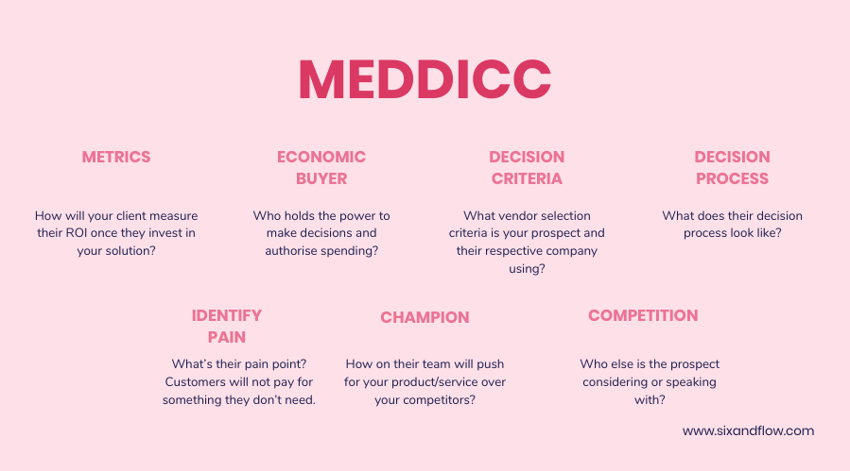


Let’s talk BANT vs MEDDICC: What's the difference





As salespeople, we are used to working with different frameworks and guidelines on how to sell effectively. Let's explore the BANT and MEDDICC frameworks.
When a prospect books time to speak with us, we go through a process to research who they are, what brought them to us, and also work to qualify them.
In a perfect world, every solution would work for everyone.
However, realistically speaking, you need a framework to work with to ensure you’re bringing in high-quality leads that will convert into positive and long-term customers.
There are many frameworks available that can work for salespeople, but the two most common are B.A.N.T and M.E.D.D.I.C.
B.A.N.T. vs M.E.D.D.I.C.C.
You may already be aware of what these more commonly used acronyms mean, but if you’re new to this or not sure, I’ve got you covered.
BANT: Budget, Authority, Need and Timing.
BANT is most effectively used as a guideline to run through while you’re speaking with a prospect or opportunity, as opposed to a true investigative tool.

Budget.
Successful salespeople must find a way in the early stage of the process to determine “If my service or product matches the needs you are looking for, do you have the Budget available to continue moving forward?”
Newer salespeople tend to be nervous discussing it but it is one of the single most important factors you need to consider and it should not be overlooked.
It is incredibly important to determine early on in your conversations whether you and your lead are aligned in what your service or product is actually going to cost them.
Getting a sense of their budget also gives you insight into what they will prioritise and perhaps what can be added on or upsold later in the process.
Authority.
Once the budget has been established, you need to discuss and clarify if the person you are speaking with is the decision-maker. Who has the authority in making decisions?
If you go through the qualification process and move the lead through the discovery stage and into onboarding only to find out you have not been speaking to the correct stakeholders, you have wasted time.
It’s important to identify the correct person or persons of authority at the company you are speaking with.
Get them to the table early on to ensure transparency in your communications at all times.
Need.
This is your best negotiation tool. If their need for your product or service is high, you are much more likely to close the deal successfully.
The sales team needs to work efficiently to establish whether the lead’s interest was curiosity-based, or if there is an actual need to solve a problem or pain point.
This helps determine what to expect in terms of when the deal should close favourably.
It also ensures your sales pipeline is not filled with opportunities that often go cold and require more chasing.
Timing.
Last but not least, we have the time frame stage of this framework.
Salespeople need to identify expectations and goals from their leads as soon as possible.
This helps in terms of allocating resources to opportunities that have the need and intention to close quickly.
If you put all of your resources into something that won’t be progressing forward for months, and they are still in the exploraroty phase, that leaves you unprepared to focus on the needs of those ready to proceed and close the deal right away.
Some would argue that N (needs) and T (timing) are the same, but the difference is that timing should still be evaluated separately.
The lead still may need your offering in the future, but just aren’t ready to proceed and close the deal anytime soon.
There is still a place for BANT in modern-day sales processes.
In my humble opinion, it should be used as a guide for salespeople, and not as a specific tool in the qualification process.
MEDDICC: Metrics, Economic Buyer, Decision criteria, Decision process, Identify pain, Champion, and Competition.
Stay with me now.
In today’s modern B2B sales frameworks, we are finding this to be more effective in terms of qualifying and understanding a prospect’s intent and distinct allocation of resources at an early stage.
Let’s break this down.

Metrics.
This is a quantifiable and measurable result that your customer will expect after they sign a deal with you.
How will your client measure their ROI once they invest in your solution?
Early on in your sales process, you need to ask questions to determine this, such as
- “What does a successful project look like to you?”
- “What specific problems are you looking to solve following the implementation of our services and/or product?”
These questions work to ensure you understand the needs of your prospect before they go through the implementation or onboarding process.
Economic buyer.
Simply put, who holds the power to make decisions and authorise spending? Think of this as you would the A from BANT.
Even if the initial person you are speaking to isn’t the decision-maker, you need to know how close you are to getting the deal approved and ultimately closing the sale.
Listen to their needs and expectations.
Use that information to determine key metrics for that person you are speaking with.
It’s your job to make the Economic buyer feel confident that your solution can justify the investment and they can proceed forward in their decision making.
Decision criteria.
This is the formal internal evaluation/vendor selection criteria your prospect and their respective company use.
If this is discovered properly during the initial conversation, this knowledge will give you a huge advantage.
You can use the information they are looking for to make their decision, and present that as part of your proposal or offer when looking to sign and close the deal.
What happens if your lead is not clear or doesn’t know the specifics of the decision criteria?
You need to be clear that the criteria is necessary to avoid devoting time and effort to projects that turn out to not be as pivotal for their particular use case.
Get them to agree on a clear list of what they need to continue moving forward in their decision-making process.
Decision process.
Criteria tells you what goes through their mind in making decisions, whereas the Decision process will tell you how they will make the actual decision.
Is this process decided by one specific person? A team? How big of a role is the budget in this process? Do they have legal restrictions?
The faster you become aware of their specific decision process the easier and more productive your meetings and presentations will become.
Identify what they need, and who it should be directed at, then make it clear you understand their internal process and get your sales deal closed faster.
Identify pain.
This is why they booked that initial meeting with you. What’s their pain point? Their problem they want you to solve?
Customers will not pay for something they don’t need.
It’s your job to be curious, ask questions about what brought them to you. The more you can find out, the better you can be at making sure they are a good fit for your business.
Leverage the information they provide to highlight how your product or service will relieve stated pain points and provide value.
Champion.
This person is your direct advantage within your prospective opportunity.
You need to identify who your solution or product will directly benefit from to justify being pushed in front of your competition to the Economic buyer.
The champion has an investment in making sure you succeed.
They want to use your product or service to make their day-to-day life easier.
Seniority for this position doesn’t matter.
In my experience, whoever has enough influence within the company you are speaking with that can use that influence to effectively push for the internal change needed to get your sale closed quickly.
Competition.
This last step is pivotal in highly competitive markets.
Salespeople have to discover “Who else is the prospect considering or speaking with?” “What do they think about that company compared to yours?” “What makes your solution differ from whomever else they are meeting with?”
Using this information, you can identify and highlight your company’s unique value proposition.
Consider developing internal battle cards to have competitive advantages prepared should your prospect ask what differentiates your company from competitors.
Which sales qualification framework is better?
If you ask me, in today’s world of qualifying and selling to leads, I think there’s a place for all sales processes.
John Kaplan, sales leader and co-developer of M.E.D.D.I.C.C. at PTC, said to think of M.E.D.D.I.C.C. like an x-ray on your sales process as compared to B.A.N.T.
This gives you direct insight into what’s broken, what needs fixing and uses the elements discovered to clearly identify if an opportunity is a good fit for your sales pipeline.
Both methods work in similar ways to obtain clarity on your direct understanding of your prospect before you devote resources to get them to sign.
Neither method should be used as a checklist for your salespeople but instead utilised as a guide in your sales process.
Take the time to consider what framework or combination of frameworks works best for your team to implement as a guide in helping ensure your salespeople focus on the customers that will fit best for your business.








